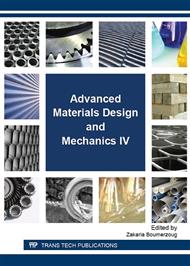[1]
J. J. Liu, T. H. Li, Study on fiber and damage of composite fabric made by needle punched carbon cloth and web, J. Carbon Techniques. 27(5) (2008)13-15.
Google Scholar
[2]
A. Lacombe, 3D Novoltex and Naxeco Caron—Carbon Nozzle Extensions: matured, industrials and Available technologies to reduce programmatic and technical risks and to increase performance of 1auncher upper stage engines, Aiaa/asme/sae/asee Joint Propulsion Conference & Exhibit. (2008).
DOI: 10.2514/6.2008-5236
Google Scholar
[3]
R. Zheng. R.L. Ji, Progress in studies on the technology of preparing preform of carbon composite by needle punched, J. Carbon, 01(2011) 33-37.
Google Scholar
[4]
S. L. Wang, S. Lei and J. Zhou, Mathematical model for determination of strand twist angle and diameter in stranded wire helical springs, Journal of Mechanical Science and Technology, 24 (6) (2010) 1203-1210.
DOI: 10.1007/s12206-010-0333-4
Google Scholar
[5]
Z. M. Qiu, Solid rocket motor material and craft, Aerospace publishing house, Beijing, (1995).
Google Scholar
[6]
E. Fitzer, L. M. Manocha, Carbon Reinforcements and Carbon/Carbon composites, April (1998).
DOI: 10.1007/978-3-642-58745-0
Google Scholar
[7]
M. Montaudon, Novoltex textures for thermostructural materials, Joint Propulsion Conference, (1991).
DOI: 10.2514/6.1991-1848
Google Scholar
[8]
M. J. Evans, R. Fisher and K. A. Williams, Ultra-high performance carbon composites, USP 5503893 (1996).
Google Scholar
[9]
P. W. Sheehan and R. S. Liew. Process for forming fibrous structures with predetermined Z-fiber distributions, USP 6237203 (2001).
Google Scholar
[10]
W. D. Thompson, T.W. Sundburg and D.R. Snyder. Apparatus and technique for making carbon brake discs, USP 6083436 (2000).
Google Scholar
[11]
X. Xiong, B.Y. Huang, Investigation of braking properties of carbon-carbon composites [D]. Central South University, 2004. 6.
Google Scholar
[12]
H. M. Huang, Thermo chemical ablation of spherical cone during re-entry. J. Journal of Harbin Institute of Technology, 18(1) (2001)18—22.
Google Scholar
[13]
A. L. Ji, H. J. Li, The development and application of needle preform. J. Carbon techniques, 12(3) (2010) 23-27.
Google Scholar
[14]
J. J. Liu, T. H. Li, Z. B. Zhao, et al, Investigation on structure and thermal properties of C/C compo site reinforced by needle punching composite fabric, J, Journal of Solid Rocket Technology, 29(1) (2006) 60-62.
Google Scholar


